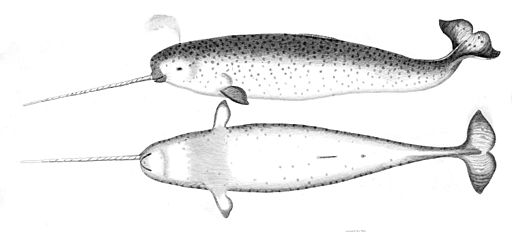You may not have heard of the Narwhals before, as this unique species of whale is not as widely known about as the Blue Whale or the Killer Whale and is mainly found in the waters around the Canadian Arctic and Greenland – not that accessible for most people. The Narwhal is related to the Beluga whale and together they make up the Monodontidae family.
The Narwhals are a medium sized whale like many others – they run to between three and five metres in length and they have a carnivorous diet, which includes a whole range of different snacks such as fish, mollusks and crustaceans. Whilst the Beluga whales have a good set of teeth, the Narwhals only have two teeth, one of which isn’t even inside their mouths! It’s this second tooth, which forms the most distinctive feature of the Narwhals – the large helical tusk that looks a lot like a unicorn horn.
The tusk is actually the Narwhal’s second tooth and sticks out from the left hand side of the jaw. The length of this fascinating feature varies with the individual Narwhal but it is something that continues to grow throughout the creature’s life. The tusk is usually around 1.5 metres long, to 3.1 metres long and some unique Narwhals (around one in every 500) actually has two tusks –  where the Narwhal’s second tooth also grows out of its jaw. Usually the Narwhals that produce the double tusks are male and there have not been many recorded discoveries of females with two tusks.
In the Narwhal world, size does matter and the length of the male’s tusk is likely to determine where that creature sits in the hierarchy of any group. Whilst the tusk looks pretty savage, it’s actually hollow and not at all heavy. Nevertheless it could still do some damage if used as a weapon. However, the Narwhals don’t really use their tusks as a weapon and there have been very few instances where Narwhals have been seen using their tusks to fight eachother. This enormous denture has fascinated scientists over the years, as there doesn’t seem to be a particular reason for a whale to have a huge tusk. Generally, the tusks seem to be more of a status symbol, or they may also be used as a tool to break through sea ice so that the Narwhal can get to the air above.
Narwhals tend to live quite long lives – normally up to 50 years – and unfortunately it is usually the lack of access to air that kills Narwhals. This happens when the freezing waters which they inhabit develop a thick layer of ice that the Narwhal can’t break through, or find a gap in. They can also be hunted by polar bears, killer whales, Greenland sharks or walruses, although this is usually only at a very young age.
Humans are of course the other risk to Narwhals. In Medieval times the Narwhal was thought to be the unicorn of the sea, a creature with mystical powers, which of course led to attempts to try and get hold of its tusk so that human beings could wield their own magic powers. Although there’s never been any proof that a Narwhal tusk brings the bearer any special good fortune, it’s said that Elizabeth I was given one and that it hung in Windsor castle for several decades – and as Queen of England for more than 50 years, she didn’t do too badly for herself…
Amy is a freelance writer who loves anything to do with marine life. She writes for Royal Caribbean Cruises in the UK and is happiest when out on the high seas!
 Follow
Follow






Speak Your Mind